From an office at 315 West Markham Street in downtown Little Rock, the first issue of The Southern Guardian was published on the Annunciation, March 25, 1911.
Two men, Thomas Mattingly and Fred Snodgrass, worked all day and evening to print the eight-page publication and get it addressed and bundled for the post office. They loaded a wheelbarrow at midnight with 2,000 copies of the newspaper and pushed it two blocks to the post office.
Since Bishop Morris arrived in 1906 from Tennessee, he had wanted to start a newspaper to educate the 22,000 Catholics in the state. He named vicar general Msgr. J.M. Lucey, a Confederate veteran of the Civil War and pastor of St. Joseph Church in Pine Bluff, the founding editor.
The newspaper would be printed 52 times a year for an annual subscription price of $1.50.
As sort of a stamp of approval, Bishop Morris included “the bishop’s approval” in the first issue and on the newspaper letterhead. “The Southern Guardian is the official organ of the Diocese of Little Rock, and I pray God that it may be an earnest champion in the cause of right, justice and truth and an ardent defender of the religion which we all love so well. I extend to it my blessing with the sincere hope that its career may be long and prosperous,” it stated.
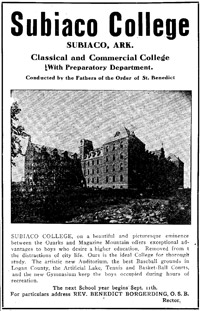 |
| This Subiaco College advertisement appeared in The Southern Guardian in 1911. |
After its first anniversary, the bishop wrote a letter to the manager, Victor Spalding, saying, “The Guardian will prove a great power for good in the diocese, and you need not to have any fear that your best efforts put forward in its behalf will go unrewarded.”
The eight-page broadsheet newspaper was quite different from what readers are used to today.Photographs were rare, and many of the articles were infused with commentary and opinions. By today’s standards the first issues really didn’t contain “news.” Historical articles about Catholicism in Arkansas were common.
Early advertisers included Subiaco College, Mount St. Mary Academy and Healey and Roth Funeral Home.
The newspaper offices were moved to Fourth and Center streets in 1912, and in 1919 it moved to offices on West Second Street, where it remained until 1967.
In 1915 the word “Southern” was dropped from the newspaper’s name. Father George H. McDermott debuted his weekly column called “Question Box.” The column was written over the decades by different priests.
1920-1929
The newspaper took on a different feel as more international news was introduced into the newspaper though the Foreign News Service. With Father Stocker’s death in 1922, Father McDermott was named the editor. The newspaper owned its own press and linotype machine to print each issue.
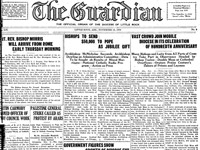 |
| Nov. 16, 1929: Despite the stock market crash less than a month before, Church news dominates the front page of The Guardian. More international news became available in the 1920s through the National Catholic Welfare Conference Press Service, an arm of what became the U. S. Conference of Catholic Bishops. |
“The Catholic Press deserves the enthusiastic and generous help of all Catholics. Their support should go beyond the mere subscription to the Catholic paper of the diocese. Catholics should try to understand the needs of the Catholic Press; they should acquaint themselves with its actual achievements, and with the opportunities that are at hand to develop still further its tremendous power,” according to the bishops’ statement.
Since that time, the diocesan newspaper has supported Catholic Press Month and encouraged Catholics to subscribe or renew their subscription during February.
1930-1939
When Father McDermott died in 1933, Msgr. J.P. Fisher and Father Harold Heagney followed as editors. Each of these men worked only part time for the newspaper while handling other diocesan and parish duties. With the Depression in the 1930s, the newspaper never stopped being published but operated at a financial loss. The first full-time editor was Msgr. Thomas J. Prendergast in 1935. He was credited with transforming the struggling weekly newspaper into an award-winning publication over the next 23 years.
For 30 years a standard part of the newspaper was a front-page column called “Qui Vive?” which is French for “Who Lives?” Msgr. Thomas L. Keaney originated the column under the pseudonym “The Sentry.”
Also in 1935 the newspaper made the bold move of reducing its subscription rate from $2 a year to $1. “The Guardian will accomplish its greatest good by entering the greatest possible number of Catholic homes in Arkansas,” an article stated.
1940-1949
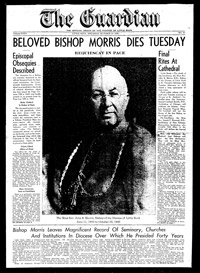 |
| Black borders the front page of this October 1946 issue reporting the death of Bishop John B. Morris. |
Even after 30 years as the bishop, Bishop Morris continued to promote the importance of a Catholic press. In a front-page letter, he wrote in 1943, “It would please me immeasurably to have every parish in my diocese able to claim The Guardian is going into every Catholic home. Only then can we expect to have the full benefit of a diocesan newspaper; only then can we expect The Guardian to be strong and useful.”
In 1946 the newspaper’s founding publisher, Bishop Morris, died.
1950-1959
In 1950 the first Catholic gift shop was opened by the newspaper. It provided supplemental income to operate the weekly publication. In 1954, William O’Donnell joined the staff. O’Donnell, a New Jersey native, had extensive newspaper experience in New England. When Msgr. Prendergast became a full-time pastor at Immaculate Heart of Mary Church in North Little Rock (Marche) in 1959, O’Donnell took over the newspaper and became its first lay editor. When Msgr. Prendergast left as editor, he had led the newspaper for 23 years, nearly half of the newspaper’s existence.
“Father Tom was my journalistic father in Arkansas and he was an ‘uncle’ to my children,” O’Donnell wrote in 1979 on his 25th anniversary at The Guardian. “Msgr. Prendergast put me through sort of a novitiate.”
Unlike secular journalism, O’Donnell said Catholic newspapers’ primary function is to teach.
O’Donnell first broadcast his radio program “The Guardian Reporter” on local and world Catholic news in 1955. It could be heard around the country each Saturday.
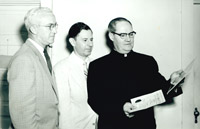 |
| Assistant editor William O’Donnell (left), business manager August Probst and editor Msgr. Thomas J. Prendergast look at award certificates from the Catholic Press Association in the mid-1950s. |
1960-1969
In 1961, for its 50th anniversary, the newspaper’s appearance changed dramatically by becoming a tabloid. More diocesan newspapers were choosing to publish in the smaller format.
“Consideration both for readers and for advertisers figured prominently in the decision to adopt the tabloid format. The half-size page makes for easier handling of the newspaper by readers and at the same time it enhances the publication’s advertising value,” a front-page article in the Feb. 3, 1961, issue explained.
In the Feb. 24, 1961, anniversary issue, Bishop Albert L. Fletcher wrote, “A half a century is a long time for any Church activity began under the trying and sometimes precarious conditions of pioneer life. Possibly the life of a Catholic newspaper in a missionary country is more precarious than almost any other activity undertaken by the Church.”
Bishop Fletcher asked readers to rededicate themselves to the “cause of the Catholic press.”
“It is become more important with the passage of years,” he wrote.
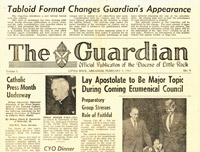 |
| Feb. 3, 1961: Tabloid format, half the size of its former broadsheet size, was a radical change for The Guardian, just a few issues ahead of the paper’s 50th anniversary. |
When St. John Seminary closed, the newspaper offices were moved from downtown to the old seminary along with the bishop’s office and other diocesan offices in 1968. “Typographical and composition work” continued to be performed in an auxiliary office at Roto-Lith Publishers in North Little Rock.
During Vatican Council II, Bishop Albert Fletcher attended every session in Rome and would mail back letters. The Guardian made every effort to publish these letters and inform the readers about the major decisions.
1970-1979
In 1972 the newspaper announced a reorganization of its business operation. The decision came after more than a dozen diocesan newspapers around the country were forced to quit publishing because of the financial strain.
Father J. Gaston Hebert led the editorial advisory board that suggested several changes to be made. An editorial page was reinstated and the requirement to publish all local news was abolished in 1975.
“I am sure that no other item coming into your home gives such a good return on your investment,” Bishop McDonald wrote in 1978. The weekly subscription was $7 a year.
O’Donnell was installed in the Knighthood of the Order of St. Gregory the Great, one of the highest papal honors, in 1975.
1980-1989
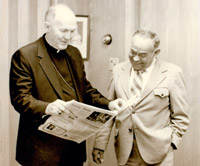 |
| Bishop Andrew J. McDonald looks over the paper with Karl Christ, who became editor in 1981. |
With the March 21, 1986, issue, the newspaper made another big change. It was renamed Arkansas Catholic in honor of its 75th anniversary. A redesign also included a new format, typeface and column width. Christ called it a “rebirth” and a “new era.” No explanation for the name change was given, but it is believed that the name would better signify who the newspaper represented and was more contemporary.
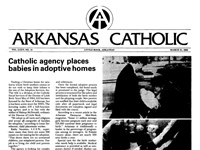 |
| March 21, 1986: On the newspaper’s 75th anniversary, its name changed to Arkansas Catholic. |
In 1984 the newspaper had 13,400 subscriptions.
1990-1999
Pete Hoelscher joined the staff in 1993, followed by Malea Hargett in 1994. With Father Schneider’s departure in 1994, Msgr. Francis I. Malone stepped in as managing editor. From 1997 to 2000 Danny Straessle served as managing editor. Since 1997 the newspaper has not had a priest on staff but has worked closely with a priest assigned as the theological consultant. Father Erik Pohlmeier was named the theological consultant in 2003 after Msgr. Malone was relieved of those duties.
2000-2011
With Bishop J. Peter Sartain’s arrival in 2000, the newspaper underwent a major redesign. When the newspaper changed to a new printing company in 2003, it was able to add four-color photographs and artwork to its pages for the first time.
Three separate times the newspaper has published special glossy color magazines. The first was when Bishop McDonald turned 75 years old in 1998. The second time came in 2000 when Bishop Sartain was ordained a bishop. The most recent appeared in 2008 when Bishop Anthony B. Taylor was ordained.
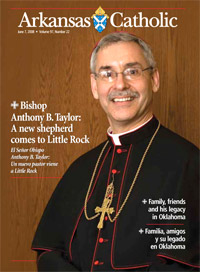 |
| June 7, 2008: As Bishop Anthony B. Taylor arrived in Little Rock, Arkansas Catholic published a full-color glossy magazine, its first to be published in both English and Spanish. |
In 2004 the newspaper website, http://www.arkansas-catholic.org, was launched followed by the diocesan website, http://www.dolr.org, in 2006.
Book publishing was another endeavor the newspaper staff undertook when Bishop Sartain decided to publish a compilation of his best-known columns. “Of You My Heart Has Spoken” was published in 2005 and is now in its sixth printing.
In October 2010 the newspaper launched its first Guardian Angels campaign to raise money for a redesign of the newspaper and website. Another important goal was to raise money to begin the costly project of digitizing the first 91 years of issues and making them searchable on the Internet.
As on many important anniversaries in the past, Arkansas Catholic unveiled a new design on Feb. 5, 2011. The digital archive project also began in February. The first bound volume was shipped to Maryland where it received “white glove” treatment in order for as many pages as possible to be scanned. The first 12 months of The Southern Guardian are now available through www.arkansas-catholic.org.
For 70-plus years the small staff published a newspaper 52 or 53 times a year. In the 1980s the decision was made to cut back production to 48 times a year to allow the staff to take vacations and upgrade equipment. In 2009 the frequency was reduced to 46 times a year.
Today the newspaper has 8,100 subscriptions.
While much has changed, gathering news with a pen and paper, printing black ink on newsprint each week and mailing a weekly newspaper throughout the state has been a constant in the Diocese of Little Rock.
Please read our Comments Policy before posting.
Article comments powered by Disqus The devil? Don't 'self-diagnose': follow Church guides
The devil? Don't 'self-diagnose': follow Church guides
 Planned Parenthood’s report shows increase in abortions
Planned Parenthood’s report shows increase in abortions
 Studio 3:16 offers new approach to teaching religion
Studio 3:16 offers new approach to teaching religion
 After three decades, NLR principal plans to retire
After three decades, NLR principal plans to retire
 CHS athlete overcomes odds to reach collegiate goal
CHS athlete overcomes odds to reach collegiate goal
 St. Joseph a model of solidarity with immigrants
St. Joseph a model of solidarity with immigrants
 Two gifts after Jesus’ death: Virgin Mary and Eucharist
Two gifts after Jesus’ death: Virgin Mary and Eucharist
 Why we have an altar, and not just a communion table
Why we have an altar, and not just a communion table
 Pope: Wars should be resolved through nonviolence
Pope: Wars should be resolved through nonviolence
 Living relationship with Jesus Christ in the Eucharist
Living relationship with Jesus Christ in the Eucharist